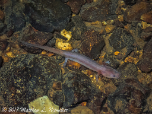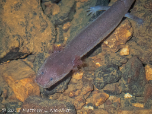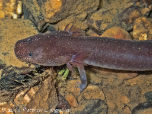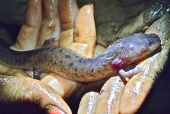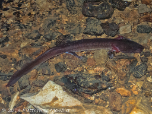Berry Cave Salamander (Gyrinophilus gulolineatus)
Description: This salamander resembles the Tennessee cave salamander (Gyrinophilus palleucus) but grows to a larger size, has a more spatulate snout, a broader head and more pigmentation. The premaxilla bones at the tip of the snout are completely divided in adults of this species while they are not in the Tennessee cave salamander. The larvae have small, functional eyes and they can detect vibrations in the water with the help of mechanoreceptors which are located on the head and sides. If they proceed to the full adult state, their eyes become functionless.
Habitat: Gyrinophilus gulolineatus is a paedomorphic species that are found in freshwater, inland habitats, specifically in caves. Due to their inaccessible subterranean habitat and ability to blend into the environment, little of G. gulolineatus life-history have been documented.
Range: This salamander is known from caves in the Ridge-and-Valley Appalachians of eastern Tennessee; its range is smaller than that of the spring salamander (Gyrinophilus porphyriticus) and is completely inside it, and the two species sometimes inhabit the same cave systems.
Found in these States:
TN
Diet: Primarily aquatic invertebrates.
Reproduction: Members of Gyrinophilus become sexually mature without metamorphosing into an adult form; although data is not conclusive, female, and male individuals are recognized as sexually mature at about 70 mm snout to vent length.
Status: G. gulolineatus inhabits a limited number of caverns in the mountains of East Tennessee, and the total area it occupies is less than 1,900 square mikes. In the Berry Cave for which it was named, the population seems to be declining, and its population overall is unknown. The International Union for Conservation of Nature has rated its conservation status as "endangered" and advocates protection of the watersheds that drain into the underground systems in which it lives.
»» Kingdom: Animalia - Animals
»» Phylum: Chordata - Chordates
»» Subphylum: Vertebrata - Vertebrates
»» Class: Amphibia - (Amphibians)
»» Order: Caudata - Salamanders
»» Family: Plethodontidae - Lungless Salamanders
»» Genus: Gyrinophilus
»» Species: Gyrinophilus gulolineatus - Berry Cave Salamander
This article uses material from the Wikipedia article "Berry Cave Salamander", which is released under the Creative Commons Attribution-Share-Alike License 3.0. Content may have been omitted from the original, but no content has been changed or extended.
|



